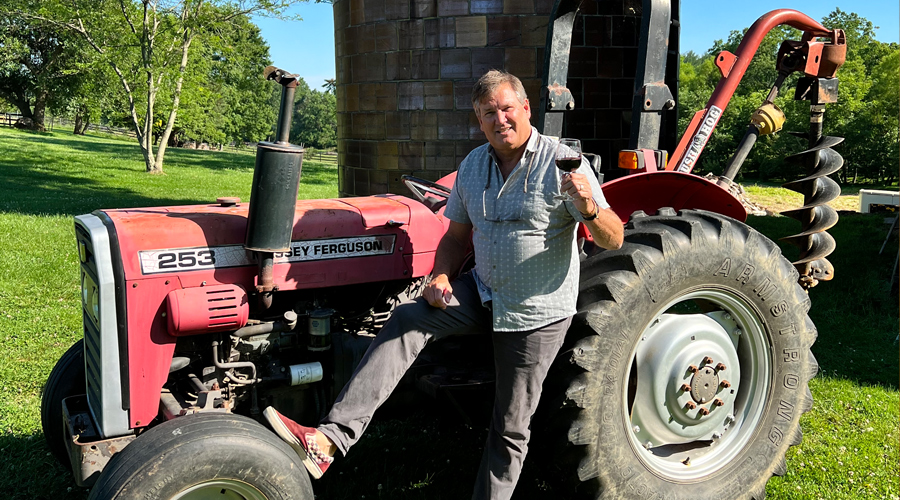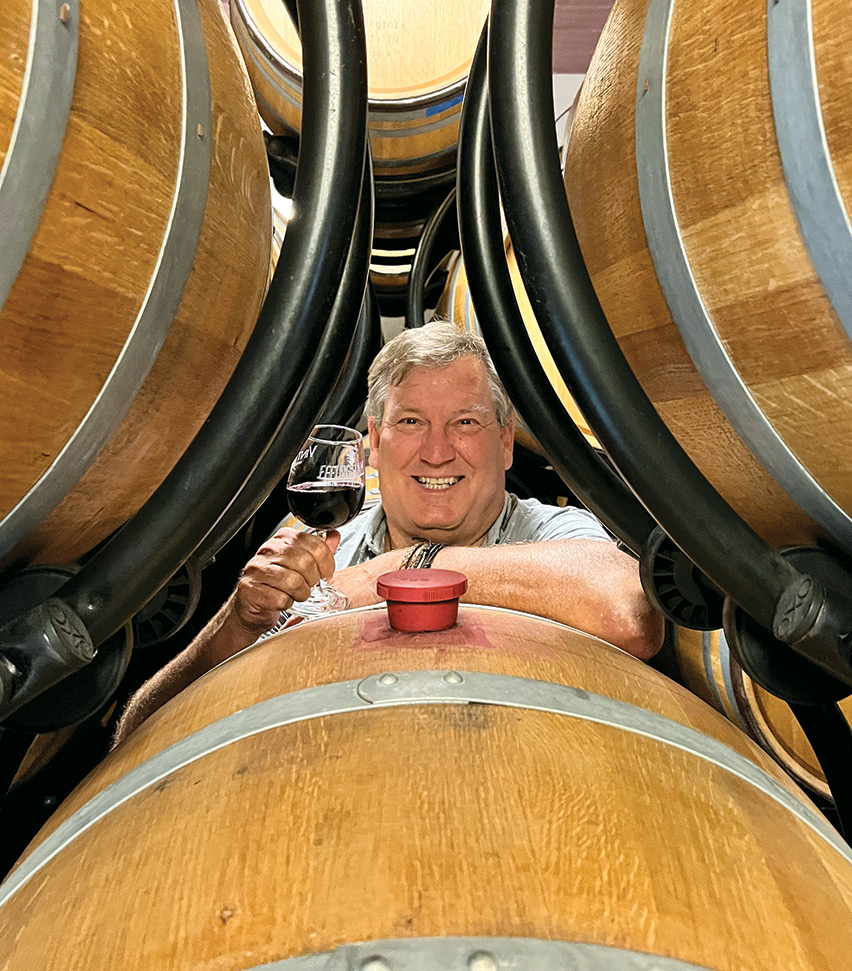
A sit-down with innovative wine industry leader Chris Pearmund on his latest endeavor—the first of its kind
[This piece originally appeared on p. 56 in the Q3 2022 issue of MD Next (our inaugural issue). Check it out to see photos and more info.]
~By Julie Fanning
The 400th anniversary of Virginia winemaking was celebrated in 2019. Initially it was quite challenging for colonists and farmers to cultivate the vines brought from Europe in Virginia’s humid climate, soil conditions and plagued by various diseases. By the 1800s real progress took place, from the discovery of the native Virginia grape, the Norton, to the grafting of European vines to make them more resilient to Virginia’s harsh growing conditions.
Fast forward through the 20th century, from struggles during prohibition to the second act of Virginia’s wine industry starting in 1967 and really taking off in the 1980s. Winemaking continued to evolve and adjust. This is where Chris Pearmund enters into the Commonwealth’s wine story.
Winemaker Chris Pearmund has an eclectic background, from a stint in the U.S. Air Force to coursework in Marine Biology when he was in California. But it was his time taking restaurant classes as a young teen, working in commercial kitchens, becoming a chef and getting more exposure to fine dining and fine wines that solidified his direction to become a winemaker. He basically consumed himself with learning all that he could by visiting various Virginia wineries and by the late 1980s worked for one winery and delved into the entire winemaking process, learning all components of the business. By 1993 he purchased his first vineyard and subsequently aided in 17 Virginia winery openings; his entrepreneural mindset in an industry and art that has flourished for thousands of years took flight.
In his career as a winemaker, Chris Pearmund has spearheaded many wine industry programs for producers and consumers alike. These programs include the country’s first barrel racking system (shown on p. 61), designed barrel club ownership for wine club members and the first Vineyard Insurance program via Rain and Hall, which covers vineyard workers. He has held prestigious positions (such as president of the Virginia Vineyards Association for approximately four years and board member of the Virginia Wineries Association) and is a nationally certified wine judge by the American Wine Society. Additionally, Pearmund has unequivocally been one of the biggest advocates for Virginia winegrowers and Virginia farmers/agriculturalists, and often his projects take into consideration the historical relevance of the properties on which they reside.
Over the years Pearmund has implemented many new technologies and methodologies to the craft of winemaking—increasing efficiency and quality of the wines they produce. I recently caught up with Chris at his legacy winery, Pearmund Cellars—built in 2002 in the middle of Meriwether Vineyard, Virginia’s oldest vineyard—to talk about his latest groundbreaking endeavor: Clearly. Pearmund is the first in the United States to offer these unique clear “cans” of chilled wines, available in three options: a white blend, sangria and rosé.
Julie: What made you decide to explore this packaging option?
Chris Pearmund: We’ve been looking at cans for about four years. And it’s a very small part of the marketplace. The bigger picture to me is the carbon footprint of glass bottles. When you look at the cost of a bottle of wine, from a manufacturing standpoint, 50% of the cost is actually the packaging: glass, cork, capsule, label. And the carbon footprint is huge. So for the $80 billion wine industry in the United States, that translates to a huge carbon footprint that we are all cognizant of, and what can be done to change the public’s perception of traditional packaging, change how we do things [in our industry] and keep the product long-lived. Innovation in packaging is heavily needed in our industry. And we’ve been looking at it for 10 years as an industry—myself included.
So this company, who designed the material of the [Clearly product] packaging, is in Texas. They were looking for a canning manufacturer in the United States—and there’s a very good one that’s in Milwaukee, Wisconsin, that has high-technology canning ability for wine, and they had just sold a unit of this canning product to a company in Richmond. We are a company that they like and want to do business with. And they came to me and said, ‘Hey, we’ve got this new product in Texas. It’s never been used before. Do you want to be a guinea pig?’ And I have my hand up at every single guinea pig opportunity there is—you never know where it’s gonna go. So last summer we started with this project.
Some of the cool factors: It is clear. It has no BPA. It’s unique. It’s environmentally responsible. It’s 100% made in the United States.
The can’s material is lined with molecular absorption material which scavenges oxygen from the wine to keep it fresh longer. But because it’s clear, do you have the same concern as glass bottles, allowing the sun to degrade the wine?
Pearmund: That is a concern that isn’t addressed with this can—you don’t want to leave them in the sun or store them in a hot car for hours and toss them on ice when you get to the beach. No, you don’t do that. It’s still a bottle of wine you need to respect. Unfortunately I think this will happen because of the convenience factor.
But here’s the unique technology factor: You know sponges absorb water. A molecular sponge is incredibly small, designed to absorb certain molecules of different sizes. In the design of this package are molecular sponges to scavenge and absorb oxygen to keep the wine fresher longer. First of its type. [Previously], canned wine has had a problem because of the high acidity, low pH and alcohol, such that the product doesn’t last very long. Oxygen acts weird. The aluminum on the top acts weird.
Well it affects the taste…..
Pearmund: Not just taste, but a lot of little things happen in a low pH. Wine has not been good for [aluminum] cans and cans have not been good for wine in the past. And this is the first product—we’re the first ones in the world to use this—as a possible answer. It is completely recyclable, it has carbon footprint savings. But when this wine is canned…in the lining of this aluminum cap is a molecular absorption path for oxygen to keep the wine fresher longer. So our longevity issue should be better than [traditional] cans and the technology of not tainting the flavor from a consumer standpoint is pretty cool.
It’s also great because it’s so portable and not breakable. The can’s slim enough to fit into a cooler, you can pop it open, you don’t need an opener or to deal with a screw cap. It’s easy to have a nice glass of wine wherever you might go. But I would think it’s also a convenience factor for someone to have wine without the commitment of a bottle.
Pearmund: So this can innovation answers some of the questions of small quantity to people who want this. And one of the misconceptions—often a reality in alternative packaging is—you’re trying to make something less expensive and [appealing]. But you’re also normally putting a really crappy wine into it. So boxed wine, canned wine, magnums…that are package-saving ideas are often the result of inexpensive wines trying to bring the cost down as low as possible. When you have 50% of your cost in packaging, and 50% in product, if you take your packaging cost and drop it by 30%, your net savings on the entire product is like 15%. And you’re not competitively benefited by a 30% packaged cost drop. So if you drop your package by 50%, you’ll only have a 25% net cost savings of your entire product. You have to put cheaper wine into it to be competitive in the marketplace with alternative packaging.
There’s a lot of effort with Clearly to be a quality product. If I’m going to put my crappiest 10,000 gallons of wine in the cans and make it sweet and hide the taste, then we as an industry are shooting ourselves in the foot with innovations in packaging. Winegrowers are farmers. Carbon footprint should be primary. Done right, the economics will follow. If the quality isn’t inside the clear can, the customers won’t come back.
That method of thinking and packaging model can potentially open you up to a newer, younger demographic; from what I’ve read, 24% of wine drinkers are millennials, and 29% of them drink every night. A lot of younger people are environmentally conscious—as are boomers.
It’s intriguing to have something palatable in a portable package such as this, but I would think from a marketing standpoint, it may open things up for its sustainability as well.
Pearmund: I was in London at the wine show 10 years ago and saw something that I thought was was going to take off and we invested into it, but it never took off. It was a bag in a box. You have a collapsible bag and the box surrounds it. It was a wine-shaped box that was already 90% recycled cardboard, and it folded into itself. As the bag collapses, you’re not getting any oxygen into it and the wine lasts longer inside of the cardboard. It was designed to have wine so it’s not gonna go bad. And when that bag is empty, you rip open the cardboard and you throw the cardboard and the plastic into the recycle bin. You have a lower carbon footprint, lower-cost recyclable container. And we couldn’t get the public to do it. We tried it in three different countries.
Innovation does have to happen for a variety of reasons for sustainability of businesses as you move forward, as well as for the globe.
Pearmund: Our history in the last 150 years has been a huge amount of innovation at screaming fast pace for economic and lifestyle benefit, not for environment, and that has to change. We all have air conditioning, nice cars, paved roads, cell phones…wonderful. None of these things initially came with environmental concerns. They’re economic business development and lifestyle development.
You are not one to rest on his laurels, but seemingly look for the next improvement or idea in the wine industry—and in this case, the environment is a consideration. Any final thoughts?
Pearmund: So, clearly, these plastic cans are not the answer. This can is an innovation. It has some importance, but it is not the answer. And people can like it, ignore it, love it, embrace it, but they need to understand it. And my question and challenge is, what’s next? What can our industry and what can you as an individual do to address not just economics and lifestyle, but environment? Because those are the three legs we stand on. What’s next?
…..
Julie Fanning is MD Next’s chief creative officer. A graphic designer by trade and occasional writer by opportunity, she loves Virginia wine and how its evolution is finally getting noticed by professional and novice tasters across the globe.

CURRENT WINERIES—
Pearmund Cellars: www.pearmundcellars.com
Effingham Manor: www.effinghammanor.com
Vint Hill Craft Winery: www.vinthillcraftwinery.com
Chris Pearmund
• Winemaker
• Chef
• Restauranteur
• Certified wine judge
• Instructor
•••
• Developed the country’s first barrel racking system (shown here)
• President of the Virginia Vineyards Association 1996–2000
• First chairman of the Virginia Wine and Food Society
• Former board member of the Virginia Wineries Association
• Publisher, The Grape Press (quarterly professional vineyard trade publication)
• Instructor at the Masters of Wine program in London
• Spearheaded a limited edition red blend collaboration, Virginia’s Heritage, with 16 wineries to commemorate Virginia’s 400th anniversary of winemaking.
•••
Multiple award-winning wines which include: Chardonnay, Viognier, Riesling, Late Harvest Vidal, Merlot, Cabernet Franc, Cabernet Sauvignon, Petit Verdot, Ameritage, Tannat


